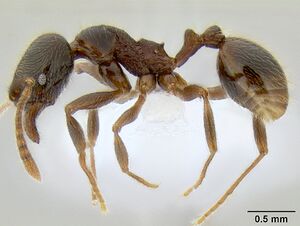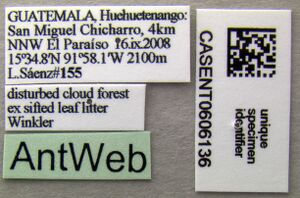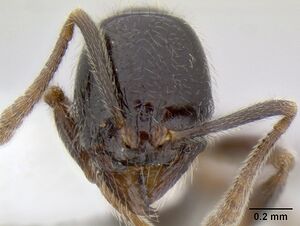Stenamma maximon
| Stenamma maximon | |
|---|---|

| |
| Scientific classification | |
| Kingdom: | Animalia |
| Phylum: | Arthropoda |
| Class: | Insecta |
| Order: | Hymenoptera |
| Family: | Formicidae |
| Subfamily: | Myrmicinae |
| Tribe: | Stenammini |
| Genus: | Stenamma |
| Species: | S. maximon |
| Binomial name | |
| Stenamma maximon Branstetter, 2013 | |
Stenamma maximon is an inhabitant of high elevation wet forest habitats (e.g. cloud forest, wet oak forest, hardwood forest, wet oak-pine forest), ranging from approximately 1700–2800 m elevation. When present, S. maximon workers are one of the most common components of the leaf-litter microenvironment, with most collections of the species made by sifting leaf litter from the forest floor. It has been collected also fairly commonly at cookie baits, suggesting that workers do forage epigeically some of the time. This is not surprising since S. maximon is a larger species of Stenamma. I have found only one nest of S. maximon, which was in a small log in leaf litter. A few stray workers have been collected also from underneath a rock. Given these observations, I would guess that S. maximon nests in wood in the leaf litter and forages both within the leaf litter and sometimes above it. (Branstetter 2013)
Identification
Branstetter (2013) - Integument mostly black, or dark brown to brown; medium-sized species (see HL, ML, PrW below); basal margin of mandible usually sinuous, with a distinct basal depression, but without a basal tooth (rarely basal margin appearing nearly straight); anterior clypeal margin undulating, with 2–4 distinct to somewhat blunt teeth; face sculpture variable, usually mostly smooth and shiny, with, at most, faint carinulae extending to about ¾ the distance to posterior margin of head, but some populations with face mostly rugoreticulate, with only area around posterior margin becoming smooth; pronotum sculpture variable, usually mostly smooth and shiny, but sometimes with some longitudinal rugulae on humeri, remainder of mesosoma with rugulae and punctae; postpetiole bulging, appearing distinctly larger than petiolar node (PPH/PH 0.96–1.14; PW/PPW 0.65–0.78); eye of moderate size (EL 0.11–0.16, REL 16–22), oval-shaped, with 6–8 ommatidia at greatest diameter (rarely 9 or 10); propodeal spines usually tuberculate, or at least forming a sharp angle, but sometimes forming a blunt angle, or becoming more developed, short (PSL 0.07–0.12, PSI 1.0–2.0). Similar species: Stenamma crypticum, Stenamma huachucanum, Stenamma ochrocnemis.
The presence of a bulging postpetiole, a sinuous basal margin of the mandible, and a toothed anterior clypeal margin, makes S. maximon easily separable from most other Stenamma species. However, S. maximon forms a complex of phenotypic variants and some populations lose the distinctiveness of the type population form and are more difficult to separate from similar species.
Keys including this Species
Distribution
Southern Mexico to Honduras.
Latitudinal Distribution Pattern
Latitudinal Range: 19.51666667° to 13.483333°.
| North Temperate |
North Subtropical |
Tropical | South Subtropical |
South Temperate |
- Source: AntMaps
Distribution based on Regional Taxon Lists
Neotropical Region: El Salvador, Guatemala (type locality), Honduras, Mexico.
Distribution based on AntMaps
Distribution based on AntWeb specimens
Check data from AntWeb
Countries Occupied
| Number of countries occupied by this species based on AntWiki Regional Taxon Lists. In general, fewer countries occupied indicates a narrower range, while more countries indicates a more widespread species. |

|
Estimated Abundance
| Relative abundance based on number of AntMaps records per species (this species within the purple bar). Fewer records (to the left) indicates a less abundant/encountered species while more records (to the right) indicates more abundant/encountered species. |

|
Biology
Castes
Males have yet to be collected.
Worker
Images from AntWeb
        
| |
| Holotype Stenamma maximon. Worker. Specimen code casent0604875. Photographer Michael Branstetter, uploaded by Default Group. | Owned by USNM. |
    
| |
| Worker. Specimen code casent0605063. Photographer Michael Branstetter, uploaded by Default Group. | Owned by MGBPC. |
     
| |
| Worker. Specimen code casent0605089. Photographer Michael Branstetter, uploaded by Default Group. | Owned by MGBPC. |
     
| |
| Worker. Specimen code casent0605136. Photographer Michael Branstetter, uploaded by Default Group. | Owned by MGBPC. |
     
| |
| Worker. Specimen code casent0605240. Photographer Michael Branstetter, uploaded by Default Group. | Owned by MGBPC. |
     
| |
| Worker. Specimen code casent0605448. Photographer Michael Branstetter, uploaded by Default Group. | Owned by MGBPC. |
     
| |
| Worker. Specimen code casent0606136. Photographer Michael Branstetter, uploaded by Default Group. | Owned by MGBPC. |
   
| |
| Worker. Specimen code casent0621541. Photographer Michael Branstetter, uploaded by Default Group. | Owned by MGBPC. |
     
| |
| Worker. Specimen code casent0621635. Photographer Michael Branstetter, uploaded by Default Group. | Owned by MGBPC. |
    
| |
| Worker. Specimen code casent0623062. Photographer Michael Branstetter, uploaded by Default Group. | Owned by LACM. |
 
| |
| Worker. Specimen code casent0603886. Photographer Michael Branstetter, uploaded by Default Group. | Owned by MGBPC. |
Queen
Images from AntWeb
   
| |
| Queen (alate/dealate). Specimen code casent0605131. Photographer Michael Branstetter, uploaded by Default Group. | Owned by MGBPC. |
   
| |
| Queen (alate/dealate). Specimen code casent0605135. Photographer Michael Branstetter, uploaded by Default Group. | Owned by MGBPC. |
   
| |
| Queen (alate/dealate). Specimen code casent0604871. Photographer Michael Branstetter, uploaded by Default Group. | Owned by MGBPC. |
Nomenclature
The following information is derived from Barry Bolton's Online Catalogue of the Ants of the World.
- maximon. Stenamma maximon Branstetter, 2013: 172, figs. 115-117 (w.q.) GUATEMALA, EL SALVADOR, HONDURAS, MEXICO (Chiapas, Oaxaca).
- Type-material: holotype worker, 16 paratype workers, 1 paratype queen.
- Type-locality: holotype Guatemala: El Progresso, Cerro Pinalón, 15.08654°N, 89.94445°W±50m., 2550 m., 30.iv.2009, LLAMA Wa-B-01-2-02; paratypes: 14 workers with same data but 15.08753°N, 89.94446°W±50m., 2550 m., 30.iv.2009, LLAMA Wa-B-01-2-28, 2 workers, 1 queen with same data but 15.08350°N, 89.95319°W±55m., 2500 m., 2.v.2009, LLAMA Wm-B-01-2-02.
- Type-depositories: USNM (holotype); CASC, CFSS, EAPZ, FMNH, ICNB, INBC, JTLC, LACM, MCZC, MGBC, MZSP, UCDC, UNAM, USNM, UVGC (paratypes).
- Distribution: El Salvador, Guatemala, Honduras, Mexico.
Unless otherwise noted the text for the remainder of this section is reported from the publication that includes the original description.
Description
Worker
(23 measured) HL 0.67–0.86 (0.79), HW 0.57–0.76 (0.68), FLD 0.16–0.21 (0.19), PCW 0.02–0.0.05 (0.04), SL 0.53–0.74 (0.68), EL 0.11–0.16 (0.12), ACL 0.49–0.65 (0.59), ML 0.84–1.09 (1.02), PrW 0.39–0.50 (0.46), PSL 0.07–0.12, SDL 0.06–0.09, PL 0.29–0.38 (0.37), PH 0.19–0.24 (0.23), PW 0.15–0.19 (0.18), PPL 0.21–0.27 (0.24), PPH 0.20–0.25 (0.25), PPW 0.22–0.27 (0.26), MFL 0.57–0.82 (0.76), MTL 0.48–0.65 (0.61), CI 83–93 (85), SI 80–101 (100), REL 16–22 (18), FLI 25–30 (28), PSI 1.0–2.0 (1.1), MFI 89–108 (89), ACI1 66–70 (68), ACI2 85–96 (88).
Medium-sized species; general body color mostly black, or dark brown to brown, with appendages dark brown to orange-brown, lighter at joints and toward extremities; setae golden brown; mandible with 6–8 teeth (usually 7), consisting of 3 distinct apical teeth, a basal tooth, and 2–4 smaller teeth/denticles, which are often worn and indistinct; basal margin of mandible usually sinuous, with a distinct basal depression, but without a basal tooth, sometimes basal margin only slightly sinuous or nearly straight; mandible often mostly smooth and shiny, with scattered piligerous punctae and some striations (type population), but sometimes surface completely carinulate, with carinulae extending from base to near teeth; anterior clypeal margin forming 2–4 distinct to somewhat blunt teeth, outer teeth often larger and sharper than inner teeth (best viewed in anterodorsal view); median clypeal lobe with a pair of faint longitudinal carinulae, apex of lobe with a short transverse carinula, remainder of clypeus mostly smooth and shiny; area in between median lobe of clypeus and anterior clypeal margin forming a distinct cavity where mandibles insert; posterior extension of clypeus between antennal insertions of moderate width (PCW 0.02–0.0.05), with sides subparallel to slightly hour-glass-shaped; frontal lobes of moderate width (FLD 0.16–0.21, FLI 25–30), not greatly covering torular lobes in full-face view; head roughly oval-shaped (CI 83–93), with posterior margin flat to slightly depressed mesad; face sculpture variable, usually mostly smooth and shiny (type population), with, at most, faint carinulae extending to about 3/4 the distance to posterior margin of head, but some populations with face mostly rugoreticulate, with only area around posterior margin becoming smooth; scape of moderate length (SI 80–101), reaching posterior margin of head when laid back; scape surface mostly smooth and shiny, with scattered piligerous punctae; flagellum with a distinct 4-segmented antennal club; pronotum and mesonotal dorsum sculpture variable, usually mostly smooth and shiny, but sometimes with longitudinal rugulae on humeri, remainder of mesosoma mostly sculptured (contrast between smooth pronotum, and sculptured mesonotum, mesopleuron, and propodeum distinctive); mesopleuron mostly punctate, with a few rugulae; side of propodeum with rugulae and some faint punctae; dorsum and declivity of propodeum with variable number of transverse carinulae; promesonotum in profile low-domed, and roughly symmetrical, but anterior declivity sometimes more sharply angled than posterior face (type population); metanotal groove in profile well-demarcated, anterior slope often smoothly transitioning with promesonotum; propodeal spines usually tuberculate (type population), or at least forming sharp angles, but sometimes forming blunt angles, or more developed and short (PSL 0.07–0.12, PSI 1.0–2.0); petiole of moderate length (PL/HW 0.46–0.56), with peduncle thick, often with anteroventral edge sharp; petiolar node in profile somewhat small (PH/PL 0.58–0.68), wedge-shaped, with anterior face longer and more sloping than almost vertical posterior face, dorsum of node rounded, and distinctly pointed posteriad; postpetiole bulging, globular, appearing distinctly larger than petiolar node (PPH/PH 0.96–1.14; PW/PPW 0.65–0.78), anterior face of node much longer than posterior face; petiolar and postpetiolar nodes mostly smooth and shiny, remaining waist surfaces punctate, with a few rugulae around bases of nodes; gaster smooth and shiny, with scattered piligerous punctae; pilosity on face short, with a layer of sparse suberect setae, and a denser layer of decumbent setae, remainder of body dorsum with longer standing pilosity; pilosity on gastral dorsum usually distinctly bilayered, with a layer of longer suberect to subdecumbent setae, and a layer of shorter decumbent setae, both layers similar in density; setae on scape and legs mostly decumbent to appressed, with some longer suberect setae on femoral venters and coxae.
Queen
(10 measured) HL 0.73–0.84 (0.84), HW 0.67–0.76 (0.76), FLD 0.19–0.23 (0.23), PCW 0.03–0.06 (0.06), SL 0.57–0.71 (0.71), EL 0.19–0.22 (0.22), ACL 0.47–0.62 (0.62), ML 1.05–1.34 (1.34), PrW 0.56–0.74 (0.74), PSL 0.13–0.17 (0.14), SDL 0.09–0.10 (0.10), PL 0.37–0.47 (0.47), PH 0.23–0.27 (0.27), PW 0.19–0.22 (0.22), PPL 0.20–0.29 (0.27), PPH 0.24–0.30 (0.30), PPW 0.27–0.33 (0.33), MFL 0.63–0.84 (0.84), MTL 0.55–0.70 (0.70), CI 91–93 (91), SI 82–94 (94), REL 26–30 (29), FLI 27–30 (30), PSI 1.4–1.7 (1.4), MFI 90–108 (90), ACI1 64–68 (65), ACI2 76–93 (87).
Same as worker except for standard queen modifications and as follows (comparison between worker and queen of type population form only): facial sculpture usually more developed (carinulae/rugulae longer and more distinct); mesopleuron mostly smooth and shiny; propodeum with transverse carinulae that wrap around entire surface; lower layer of gastral setae more dense, almost pubescent; propodeal spines (compared to worker from same population) slightly longer, more developed (PSL 0.13–0.17, PSI 1.4–1.7).
Type Material
Holotype worker. GUATEMALA: El Progresso, Cerro Pinalón, 15.08654°N, 89.94445°W ±50m, 2550m, 30 Apr 2009, cloud forest, ex sifted leaf litter (LLAMA, collection Wa-B-01-2-02) USNM, specimen CASENT0604875. Paratypes: same data as holotype but 15.08753°N, 89.94446°W ±50m, 2550m, 30 Apr 2009 (LLAMA, Wa-B-01-2-38) 1w, CASC, CASENT0623344, 1w, EAPZ, CASENT0623345, 1w, ECOSCE, CASENT0623346, 1w, FMNH, CASENT0623347, 1w, ICN, CASENT0623348, 1w, INBio, CASENT0623349, 1w, JTLC, CASENT0623350, 1w, LACM, CASENT0623351, 1w, MGBPC, CASENT0623352, 1w, MCZ, CASENT0623353, 1w, MZSP, CASENT0623354, 1w, UCD, CASENT0623355, 1w, UNAM, CASENT0623356, 1w, UVGC, CASENT0623357; 15.08350°N, 89.95319°W ±55m, 2500m, 2 May 2009 (LLAMA, Wm-B-01-2-02) 1dq, 2w, USNM, CASENT0623358, CASENT0623359, CASENT0623360.
Etymology
The specific epithet maximon refers to the folk saint Maximón, or San Simon, who is worshipped by Mayan peoples in the highlands of western Guatemala.
References
- Branstetter, M. G. 2012. Origin and diversification of the cryptic ant genus Stenamma Westwood (Hymenoptera: Formicidae), inferred from multilocus molecular data, biogeography and natural history. Systematic Entomology 37:478-496. doi:10.1111/j.1365-3113.2012.00624.x
- Branstetter, M.G. 2013. Revision of the Middle American clade of the ant genus Stenamma Westwood (Hymenoptera, Formicidae, Myrmicinae). ZooKeys 295, 1–277. doi:10.3897/zookeys.295.4905
References based on Global Ant Biodiversity Informatics
- Branstetter M.G. 2013. Revision of the Middle American clade of the ant genus Stenamma Westwood (Hymenoptera, Formicidae, Myrmicinae). ZooKeys 295: 1277
- Dattilo W. et al. 2019. MEXICO ANTS: incidence and abundance along the Nearctic-Neotropical interface. Ecology https://doi.org/10.1002/ecy.2944
- Longino J. T. L., and M. G. Branstetter. 2018. The truncated bell: an enigmatic but pervasive elevational diversity pattern in Middle American ants. Ecography 41: 1-12.


